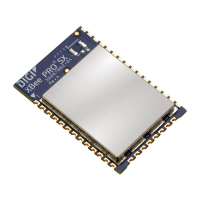PCB design and manufacturing Design notes
XBee®/XBee-PRO SX RF Module User Guide
203
Improve antenna performance
The choice of antenna and antenna location is important for optimal performance. In general, antenna
elements radiate perpendicular to the direction they point. Thus a vertical antenna, such as a dipole,
emit across the horizon.
Metal objects near the antenna cause parasitic coupling and detuning, preventing the antenna from
radiating efficiently. Metal objects between the transmitter and receiver can also block the radiation
path or reduce the transmission distance, so position external antennas away from them as much as
possible. Some objects that are often overlooked are:
n Metal poles
n Metal studs or beams in structures
n Concrete (reinforced with metal rods)
n Metal enclosures
n Vehicles
n Elevators
n Ventilation ducts
n Large appliances
n Batteries
n Tall electrolytic capacitors
RF pad version
The RF pad is a soldered antenna connection. The RF signal travels from pin on the module to the
antenna through a single ended RF transmission line on the PCB. This line should have a controlled
impedance of 50 Ω.
For the transmission line, we recommend either a microstrip or coplanar waveguide trace on the PCB.
We provide a microstrip example below, because it is simpler to design and generally requires less
area on the host PCB than coplanar waveguide.
We do not recommend using a stripline RF trace because that requires routing the RF trace to an
inner PCB layer, and via transitions can introduce matching and performance problems.
The following figure shows a layout example of a microstrip connecting an RF pad module to a
through-hole RPSMA RF connector.
n The top two layers of the PCB have a controlled thickness dielectric material in between. The
second layer has a ground plane which runs underneath the entire RF pad area. This ground
plane is a distance d, the thickness of the dielectric, below the top layer.
n The top layer has an RF trace running from pin 36 of the device to the RF pin of the RPSMA
connector. The RF trace's width determines the impedance of the transmission line with
relation to the ground plane. Many online tools can estimate this value, although you should
consult the PCB manufacturer for the exact width. Assuming d = 0.025 in, and that the
dielectric has a relative permittivity of 4.4, the width in this example will be approximately
0.045 in for a 50 Ω trace. This trace width is a good fit with the module footprint's 0.060 in pad
width.
We do not recommend using a trace wider than the pad width, and using a very narrow trace can
cause unwanted RF loss. You can minimize the length of the trace by placing the RPSMA jack close to

